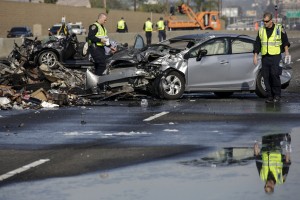Driving while under the influence is dangerous. So is driving when emotional.
Emotional driving, driving while observably angry, sad or emotionally agitated, increases the risk of an accident nearly tenfold according to new research from Virginia Tech’s Transportation Institute.
The study also stated when drivers engage in activities that require them to take their eyes off the road, their crash risk is more than doubled. Yet, according to the institute’s research, drivers are engaged in some form of distracted driving more than 50 percent of the time.
“The first and only accident I’ve ever been in was when I had a fight right before leaving for school and was crying,” Jessica Ludlow, a junior studying family life at BYU, said. “I accidentally bumped the car in front of me at a red light. It wasn’t bad, but since our car had been totaled and salvaged in the last year it ended up totaling the car for a second time.”

Gwendelynn Adams, a math teacher at Timpanogos High School, was also driving while emotional when she got in an accident. Adams was driving through an intersection where she rear-ended someone just two days before. She was nervous about making the turn, but thought she would be OK. That’s when a bee flew into her car, and Adams completely forgot she was driving.
“I have a huge fear of bees,” Adams said. “I heard the buzzing and started freaking out. I was so worried about the bee and getting stung that I completely forgot that I was driving. That’s when I crashed into the car in front of me. All the emotions from two days prior came flooding back and I lost it. I haven’t cried that hard in a really long time.”
However, emotional driving is not the only form of distracted driving. The U.S. government’s official website for distracted driving says “distracted driving is any activity that could divert a person’s attention away from the primary task of driving. All distractions endanger driver, passenger and bystander safety.”
These types of distractions include texting, using a cellphone, putting on makeup or other acts of grooming, adjusting the radio, using a navigation system and eating or drinking. However, because texting requires cognitive, visual and manual distraction, it poses the highest risk for drivers.
Approximately 660,000 drivers across America are using cellphones or another electronic device while driving at any given time. Ten percent of fatal crashes and 17 percent of crashes resulting in injury in 2011 were reported as distraction-affected crashes according to the U.S. Department of Transportation.
Emily Moon, a junior studying exercise science at BYU, was in a car accident involving a driver who was texting instead of watching the road.
“Some 30-year-old woman was texting and driving and didn’t realize that the light was red. She hit the back of our car going around 30 miles per hour,” Moon said. “The lady’s car was completely totaled and my friend’s car was in bad shape too. The accident never even would have happened if the lady was just paying attention while she was driving.”
The research conducted by Virginia Tech’s Transportation Institute also found driving significantly above the speed limit creates about 13 times the risk of an accident, yet interacting with a child in the back of a vehicle increases drivers’ aptitude to drive in a more protective manner.
Despite an increase in car safety measures, the U.S. has fallen behind in fatalities per mile. One reason could be the urge to be constantly connected. Smart technology has “the potential to escalate distraction-related crashes in the future,” according to the Virginia Tech study.
In 2013, 3,154 people were killed and approximately 424,000 people were injured in crashes involving distracted drivers.
In fact, over a third of the 11 million annual crashes in the U.S. “could be avoided” if distraction were eliminated, the study by Virginia Tech’s Transportation Institute estimates.
Drivers can minimize their risk of accidents by keeping cellphones off and out of reach, driving with headlights on, obeying the speed limit, practicing defensive driving, and driving a car with the latest safety equipment according to the U.S. Department of Motor Vehicles.




